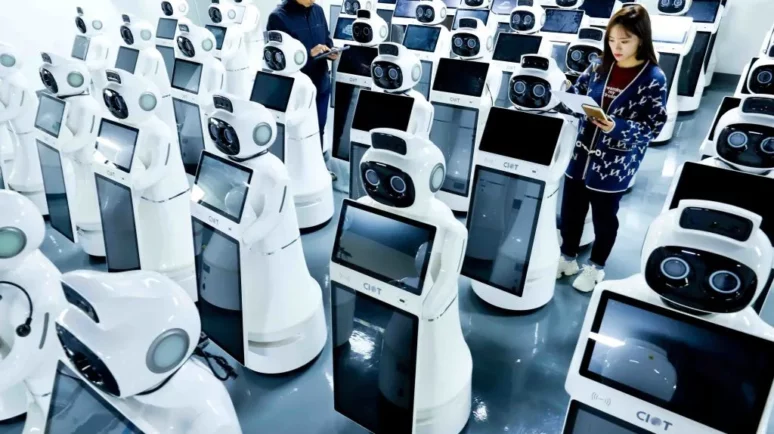AI Boom vs Dot-Com Bust: Why Today’s AI firms Are Much More Durable

Is AI going to create a new financial bubble like dot-com's one? l Source: Stefan Rousseau - PA Images/PA Images via Getty Images
Key Takeaways
- Artificial intelligence (AI) integration is accelerating across companies, not just tech giants.
- AI’s rapid evolution is reminding Internet companies of the remarkable growth in the ’90s.
- But are we faced with a new dot-com bubble?
As artificial intelligence (AI) continues its rapid evolution, an increasing number of companies – not only tech-driven ones – are integrating AI into their operations. Such swift adoption often raises concerns in the market, with parallels drawn to bubbles primed for bursting.
However, the current AI expansion differs significantly from past scenarios, such as the dot-com bubble’s catastrophic collapse.
AI Won’t Repeat Dot-Com Bubble
The recent GTC developer conference provided compelling evidence that we’re still at an early stage in the AI diffusion cycle. It underscored the growing interest in this field, with a rapidly expanding audience, customer base, and developer community. Moreover, it highlighted that major players, endowed with robust balance sheets, continue to invest substantially in AI technologies.
Dominic Rizzo, manager of the T. Rowe Price Funds – Global Technology Equity fund, shares this conviction. “There’s a significant drive to accelerate the development of data centers, particularly in integrating graphics processing units (GPUs) for enhanced speed and energy efficiency. The market is evidently growing alongside advancements in processing speed,” he said .
However, concerns linger about the possibility of an AI bubble akin to the dot-com era. Rizzo acknowledges this risk, suggesting that as valuations become increasingly stretched, a correction may become inevitable. He emphasizes that we have yet to reach a critical inflection point despite this.

The dot-com era was marked by irrational exuberance, where anything associated with a dot-com address skyrocketed, fueled by the fear of missing out. Today, we’re seeing a similar enthusiasm, but tempered by lessons learned. However, unlike the past, today’s AI leaders benefit from a more resilient ecosystem, bolstered by SaaS companies like Snowflake, Adobe, Workday, Salesforce, ServiceNow, Oracle, SAP SE, and others. These firms are better positioned to thrive in the current AI era due to their inherent resilience.
While today’s stock market may remind us of the dot-com era, there are notable differences. Unlike then, today’s leaders boast substantial earnings. Comparing Nvidia to Cisco, while apt, highlights a key distinction: today’s leaders are highly profitable, a stark departure from the profitless IPO frenzy of the past.
Comparison With ’90s Is Impossible
The current tech valuation landscape differs drastically from the exuberance of the late 1990s, where astronomical valuations were the norm. Unlike the dot-com era, today’s companies like Nvidia and Microsoft trade at more balanced forward price/earnings multiples. This reflects a shift towards profitability and sustainable growth. These industry giants, fueled by historic cash flows, are driving advancements in AI technology.
In contrast to the concentrated influence of the ‘Magnificent 7’ stocks in 2023, their impact has moderated in 2024, with returns showing notable dispersion.

Similar to the dot-com era’s focus on core infrastructure, today’s critical players such as Nvidia, AWS, Microsoft, and Google command significant attention. Meta’s open-source Llama models introduce an element of unpredictability. While open standards continue to underpin success, particularly in the AI era.
Notably, companies like Nvidia and the hyperscalers boast resilient business models, with the integration of AI into Software as a Service (SaaS) offerings poised to accelerate adoption. Established SaaS players will drive innovation in this space, further solidifying their position in the market.
Beyond AI: Opportunities In Tech
The current phase of technological advancement is undeniably exhilarating, with AI applications poised to enhance productivity significantly. Success in the generative AI sector relies on robust access to data, established market distribution channels, a wealth of engineering talent, and formidable computing power.
Moreover, experts stress the importance of fostering strategic partnerships with customers, enabling companies to deliver superior products or services and command premium prices by leveraging the productivity gains facilitated by artificial intelligence.
These characteristics are universal across industries. And lead experts to compare the current technological wave to one of the most groundbreaking innovations since electricity. Highlighting successes such as Microsoft’s GitHub Co-Pilot and Meta’s advancements in advertising metrics underscores the importance of converting ideas into tangible returns on investment. The perspective on generative AI as complementary rather than disruptive is widely shared, with emphasis placed on companies entrenched in data and enjoying customer trust as those poised for success.
In addition to AI, the tech sector presents many other enticing prospects. Insights suggest investments in payment processing stand as a strategic maneuver to leverage the expanding digital payments landscape, propelled by the ongoing transition from cash to electronic transactions.
There’s also anticipation of a ripple effect in the memory sector. To fuel this is the heightened demand for high-bandwidth memory propelled by generative AI applications. This trend is expected to breathe new life into the previously underinvested DRAM market. There’s recognition of burgeoning opportunities in the e-commerce sphere, particularly as the post-Covid economic rebound sets the stage for investment prospects in select US and Chinese firms.


